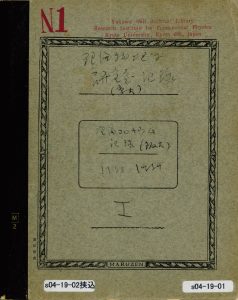Archive of historical materials

Laboratory Journal – Theory Colloquia 1938
OU1938-X1 (43 pages) Date: April 21, 1938
Yukawa obtained his degree (Doctor of Science) from Osaka Imperial University on April 5, 1938. Filled with more confidence and aspiration for conducting more energetic research activities, in that year Yukawa started to take notes of what were discussed in the study meetings and seminars held in the laboratory. The title of the collection of those notes is “Laboratory Journal – Theory Colloquia.” Written on the cover is “Laboratory of Theoretical Physics (Kyoto Imperial University)” and “Theory Colloquium Record (Osaka Imperial University) 1938 – 1939 I.” The first half of the laboratory journal consists of records of 31 laboratory activities conducted from April 21 to December 23, 1938 when Yukawa was an associate professor at Osaka Imperial University. Yukawa became a professor of Kyoto Imperial University on May 26, 1939 and took his post in the Faculty of Physics, Department of Science, Kyoto Imperial University. The second half of the journal was written after he went to Kyoto Imperial University. (The first three lines and “Osaka Imperial University,” “1939” and “I” written on the lower section were added after Yukawa became a professor of Kyoto Imperial University.)
In the beginning, Yukawa jotted down only the basic information such as the date and time, place, name of hosting organization, and topics, but from about the 7th colloquium (May 14, 1938), Yukawa began recording the details of discussions. The place of colloquium also changed to Yukawa’s living room, to the cafeteria, and then to Room 167 from the 11th colloquium (June 4, 1938).
Record of the 8th Colloquium (Page 13 in the laboratory journal):
The 8th Colloquium held on May 19 (Thursday), 1938, at the cafeteria on the 1st floor (“Cafeteria” referred to the room in the Kikuchi Laboratory used as an eating room by the members of the group.)
The laboratory journal said Shoichi Sakata explained the theory of beta decay. The beta decay is a phenomenon expressed by the following:
Neutron (N) -> Proton (P) + Electron (e) + Neutrino
The beta decay was explained by separating the process into two stages of disintegration [equation above (56)].
First stage: Disintegration of neutron (N) to proton (P) + U particle (U-)
Second stage: Disintegration of U particle (U-) to electron (e) + neutrino
The U particle (U-) was the meson (known today as pi-meson or rho meson) proposed by Yukawa. Today, it is understood that beta decay occurs due to the weak interaction (force). In 1938, however, the difference between the nuclear force and weak force was not known well, and the pi-meson was not discovered at that time. According to the explanation in the journal, the first-stage process was triggered by the nuclear force and the second-stage process occurred due to the weak force. We now know that the weak force mediated by W boson directly causes the neutron (N) to break down into a proton (N), electron (e) and neutrino. Yukawa and Sakata attempted to explain this phenomenon by trials and errors. Those discussions led to the writing of the fourth paper on the mesons (OU1938-B6, OU1938-B8) by Yukawa, Sakata, Kobayashi and Taketani. (Written by Yutaka Hosotani)


